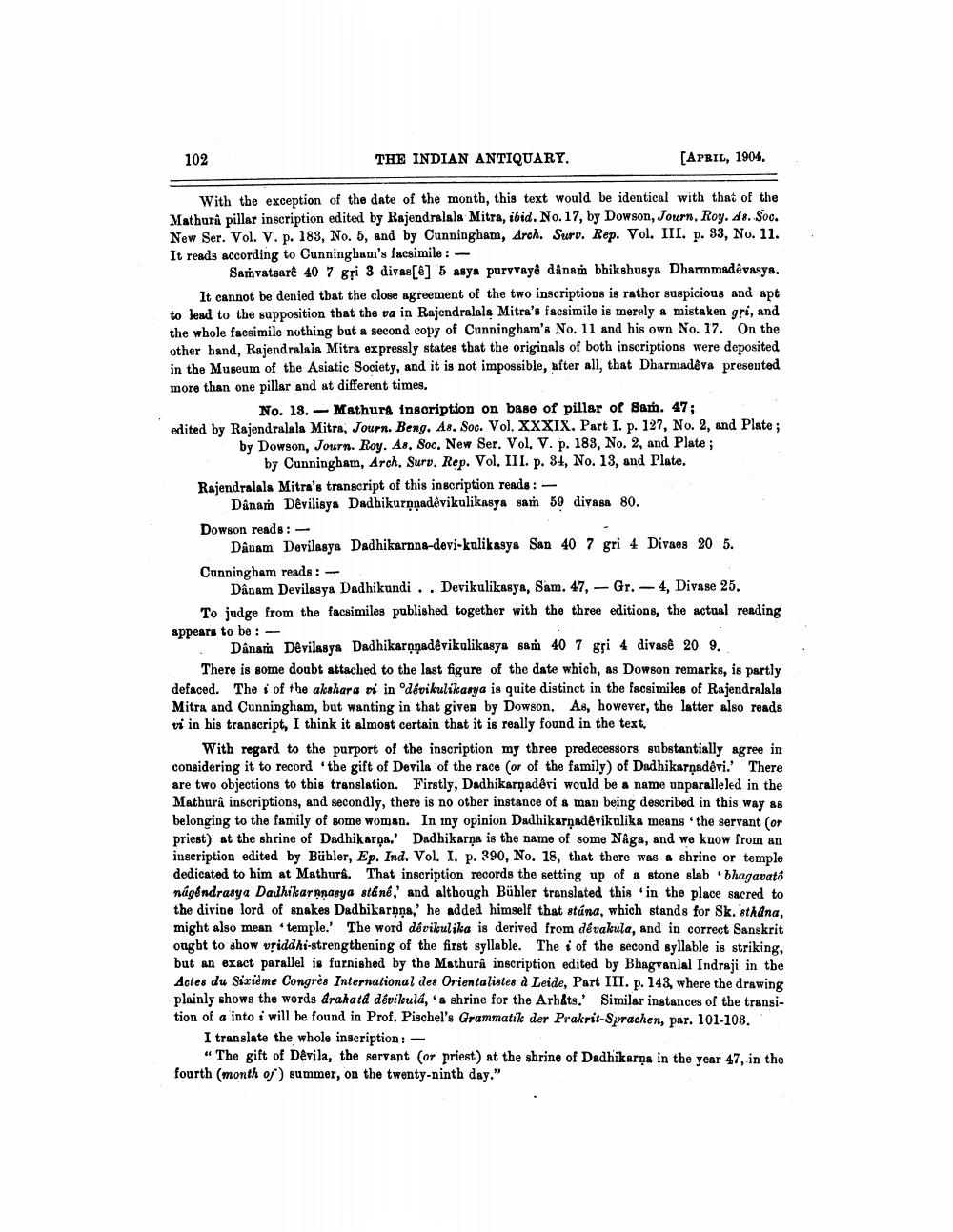________________
102
THE INDIAN ANTIQUARY.
[APRIL, 1904.
With the exception of the date of the month, this text would be identical with that of the Mathura pillar inscription edited by Rajendralala Mitra, ibid. No.17, by Dowson, Journ, Roy. ds. Soc. New Ser. Vol. V. p. 183, No. 5, and by Cunningham, Arch. Surv. Rep. Vol. III. p. 83, No. 11. It reads according to Cunningham's facsimile: -
Samvatsaré 40 7 gri 3 divas[@] 5 asya parvvayê dânam bhikshusya Dharmmadêvasya. It cannot be denied that the close agreement of the two inscriptions is rather suspicious and apt to lead to the supposition that the va in Rajendralala Mitra's facsimile is merely a mistaken gri, and the whole facsimile nothing but a second copy of Cunningham's No. 11 and his own No. 17. On the other hand, Rajendralala Mitra expressly states that the originals of both inscriptions were deposited in the Museum of the Asiatic Society, and it is not impossible, after all, that Dharmadêva presented more than one pillar and at different times.
No. 18. - Mathura inscription on base of pillar of Sam. 47; edited by Rajendralala Mitra, Journ. Beng. As. Soc. Vol. XXXIX. Part I. p. 127, No. 2, and Plate;
by Dowson, Journ. Roy. As. Soc. New Ser. Vol. V. p. 189, No. 2, and Plate ;
by Cunningham, Arch. Sury. Rep. Vol. III. p. 34, No. 13, and Plate. Rajendralala Mitra's transcript of this inscription reads : -
Dana Devilisya Dadhikuronadevikulikasya sam 59 divasa 80. Dowson reads: -
Dinam Devilasya Dadhikarnna-devi-kulikasya San 40 7 gri 4 Divaes 30 5. Cunninghem reads :
Danam Devilagya Dadhikundi .. Devikulikasya, Sam. 47,- Gr. - 4, Divase 25. To judge from the facsimiles published together with the three editions, the actual reading appears to be : -
Dana Devilasys Dadhikarnnadêvikalikasya sa 40 7 gri 4 divasê 20 9. There is some doubt attached to the last figure of the date which, as Dowson remarks, is partly defaced. The i of the akshara ni in "dévikulikarya is quite distinct in the facsimiles of Rajendralala Mitra and Cunningham, but wanting in that given by Dowson, As, however, the latter also reads vi in his transcript, I think it almost certain that it is really found in the text,
With regard to the purport of the inscription my three predecessors substantially agree in considering it to record the gift of Devils of the race (or of the family of Dadhikarnadevi.' There are two objections to this translation. Firstly, Dadhikarņadêri would be a name unparalleled in the Mathura inscriptions, and secondly, there is no other instance of a man being described in this way as belonging to the family of some woman. In my opinion Dadhikarnad@vikulika means the servant (or priest) at the shrine of Dadhikarpa.' Dadhikarna is the name of some Naga, and we know from an inscription edited by Bühler, Ep. Ind. Vol. I. p. 390, No. 18, that there was a shrine or temple dedicated to him at Mathura. That inscription records the setting up of a stone slab bhagavata nágendrasya Dadhikaranasya stáné,' and although Bühler translated this in the place sacred to the divine lord of snakes Dadbikarona,' he added himself that stúna, which stands for Sk. 8thdna, might also mean temple. The word dévikulika is derived from dévakula, and in correct Sanskrit ought to show vriddhi-strengthening of the first syllable. The i of the second syllable is striking, but an exact parallel is furnished by the Mathura inscription edited by Bhagvanlal Indraji in the Actes du Sixième Congrés International des Orientalistes à Leide, Part III. p. 143, where the drawing plainly shows the words dranatá dévikula, a shrine for the Arh&ts. Similar instances of the transition of a into i will be found in Prof. Pischel's Grammatik der Prakrit-Sprachen, par. 101-103.
I translate the whole inscription: -
“The gift of Devila, the servant (or priest) at the shrine of Dadhikarna in the year 47, in the fourth (month of summer, on the twenty-ninth day."




